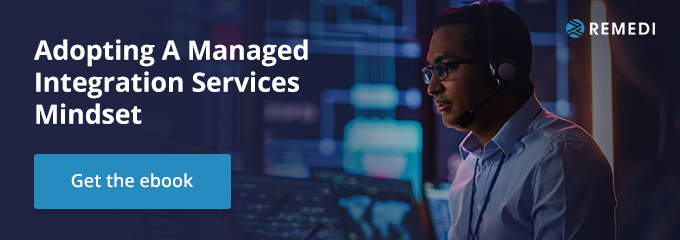
When the C-suite decides to outsource the operation and maintenance of a company’s electronic data interchange system, it can leave technology-department staff flummoxed. What’s the best outside option for EDI support, and how do you know when you’ve found it?
As businesses everywhere tighten their belts, it’s a scenario we’re likely to see more and more. C-suite executives are searching for ways to cut costs without affecting day-to-day operations, and outsourced EDI is one way to do it.
As eager as they may be to trim expenses, however, many company leaders may find the idea of outsourced or managed EDI services worrisome. They might wonder if data security or compliance will take a hit if they move their EDI management off-site, or whether the vendor will be suitably qualified or responsive to company needs.
Employees tasked with both finding a top-quality EDI services provider and allaying concerns of the C-suite have their work cut out for them – but the task can be done in a way that checks all the required boxes and then some.
Defining Outsourced EDI
EDI is akin to a language used by two or more computers to communicate. It replaces manual, paper-based systems for the standardized-format sending and receipt of business documents such as invoices, shipping notifications and delivery confirmations.
Organizations can choose from several options when it comes to EDI. They can manage their EDI systems in-house, entrust their EDI solutions to an outsource vendor or engage with an EDI managed-services provider. We break these down below.
- In-house EDI: Running an organization’s EDI system onsite requires the purchase and maintenance of all necessary hardware and software, as well as the employment of a full-time team to take care of it all. In this scenario, the business is responsible for the configuration customization, security and maintenance of the system. It must also handle software updates and any technical problems that may come up. This is generally the most expensive option.
- Fully outsourced EDI: In this set-up, an organization gives over total responsibility for EDI operations to an outside vendor. This new party handles all EDI-system aspects, including provision of needed infrastructure, data security, software, maintenance and ongoing technical support. The customer company typically pays a subscription or other fee for this service and essentially cedes control to the vendor. This route comes with significant cost savings over in-house EDI.
- Managed EDI Services: Managed EDI services is a sort of happy medium between the first two options. With this choice, an organization keeps some control over its EDI system but leverages the expertise and technical support of an outside vendor, which helps it with implementation, integration and ongoing management. Managed services save companies significant amounts of money without demanding that they give up full control of their EDI systems.
There may be varying views about outsourced EDI among senior leadership. As described previously, some may be concerned about data security, the idea of giving up control of the EDI system and whether an outside provider will provide sufficient customization or technical support.
However, the savvy IT staffer given the job of finding a high-quality, cost-effective EDI solution knows that senior executives at a company share an ultimate focus on keeping their company in the black. If the right managed EDI services provider can be found – and security, control, service and other worries allayed – the large financial savings it offers are likely to win out.
Weighing the Pros and Cons
Outsourced EDI offers several key benefits. These are:
- Cost savings: Using an outside party for EDI solutions lets an organization avoid large upfront investments, such as the purchase of hardware and software, and the ongoing cost of employing a full-time, specialized staff. This can lead to notable financial savings.
- Improved efficiency: When a company transfers responsibility for its EDI system, it also transfers management of its EDI challenges, software updates, legal compliance, daily operations and more, freeing up the company’s employees to focus on the strategic work that brings in revenue.
- Access to expertise: Vendors specialized in EDI can best ensure a company’s system runs properly. They have the deep expertise and knowledge of standards, regulations, best practices and emerging technologies to optimize processes and fix problems quickly. This access to specialized expertise enables companies to enhance operational efficiency, streamline workflows, and adapt to evolving EDI requirements more effectively.
However, there are some potential drawbacks to outsourcing EDI needs. These include:
-
Loss of control and visibility: Using an outside EDI provider can mean a company has limited control over and visibility into system customization, configuration and problem resolution.
-
Dependency on external vendors: Outsourcing can also bring with it risks, such as being locked into working with a single vendor for a specified length of time.
-
Security and data privacy concerns: When using an outside vendor for EDI management, concerns about security and privacy may arise, since having an external entity run EDI operations means sharing sensitive data. To mitigate legal risk, a company must ensure that the provider’s security measures are sufficiently robust and legally compliant.
The Managed EDI Services Solution
The managed EDI services model offers companies a middle ground between onsite EDI and wholly outsourced EDI. When using it, a business hires an outside party offering a variety of EDI services, and it chooses the ones it wants. These services might include EDI implementation, trading partner onboarding and support, map development, system integration and more.
In this model, the company retains control and ownership of its EDI infrastructure but gets to use the support and expertise of the outside-vendor team. In situations in which EDI is fully outsourced, on the other hand, the company assumes full responsibility for every part of its EDI system.
Maintaining control and visibility
Companies that want to make sure they maintain control and visibility of their EDI systems without keeping them in-house have several options. A managed-services approach allows companies to retain direct control over the customization of their EDI systems and gives them flexibility over EDI-system management. Working closely with a specialized outside provider, organizations can manage their system configurations and updates as needed.
Establishing direct relationships with trading partners is crucial to maintaining control over EDI. Rather than depending solely on the outside EDI services provider, the company can communicate and collaborate directly with its trading partners. This will help ensure a smooth integration process and maintain good business relationships.
Balancing cost savings and control
Companies that use managed EDI service providers get the best of both worlds. They maintain control over their systems while benefiting from the know-how and support of a team of experts – all at a cost savings when compared to in-house EDI.
Engaging managed EDI services allows a company to eliminate the need to hire and keep on a full-time, in-house EDI team. This means saving what it would have spent on salaries, training, benefits and more.
By relying on the experienced professionals of a vendor, a company gets experts when it needs them, but without a hefty price tag. Leveraging the expertise of its managed services vendor, a business can ensure the proper implementation of its EDI system, as well as efficient partner onboarding, robust issue resolution and accurate data mapping. Having a trusted, knowledgeable team of specialists handle its EDI needs lets a business keep its focus on its core competencies and drive better overall performance.
Assessing Management's Willingness
When presenting managed EDI services to company leadership, an employee should be sure to address any concerns about visibility, system control and cost – while also encouraging questions and open discussion about the proposed move.
The professional who has been given the job of finding an EDI-management solution should start their pitch by highlighting how the managed EDI services model would allow the company to keep both visibility into and control over its EDI system. They should stress that the company would retain ownership of both decision-making processes and infrastructure, but also get to access the expertise of the managed services provider whenever necessary.
They might choose to discuss the customization and flexibility options available for tailoring an EDI system to a company's unique needs. They should emphasize the potential cost savings that will be had from reduced staff expenses, infrastructure investments and continuous upgrades and maintenance. Providing specific examples or case studies that demonstrate success with this model will help make the case.
Finally, the employee should encourage discussion about the proposal and ask senior staffers to bring up any remaining questions or concerns. This will allow for a full evaluation of the potential solution, making certain that all aspects have been considered and that they align with company goals.
Conclusion
Managed EDI services is a viable solution to the problem of how a company can cost-effectively manage its EDI system while maintaining control of and visibility into that system. A balanced, middle-ground approach to EDI management, managed EDI services allow companies to get results they want without forcing them to cede authority of their EDI to an outside party.
The employee who has been tasked with finding the right way to manage a business’ EDI platform should thoroughly evaluate all available options and engage in open dialogue with company leadership. By contracting with a trusted managed services provider, a company will get provider support in implementation, integration, partner onboarding, maintenance and more. All the while, it will be reducing its spending and increasing the efficiency of its EDI system.
The managed EDI services model offers a balanced approach that ensures a company's specific EDI needs are met while allowing leadership to maintain control and visibility.



